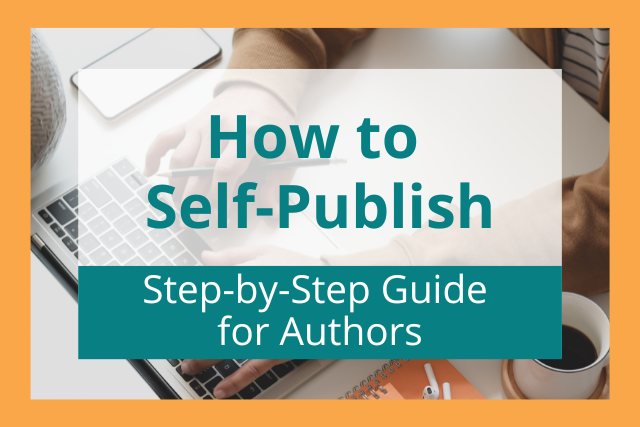
Self-publishing is an increasingly popular publishing path. You might even have heard of blockbuster hits that were originally self-published books, such as Andy Weir’s The Martian and Christopher Paolini’s Eragon.
So what exactly is self-publishing, and what do you need to do to become a self-published author?
This article will give you a step-by-step guide to self-publishing a book and help you decide if this is the right publishing path for you.
What Is Self-Publishing?
Self-publishing is the act of publishing a creative work without the help of a publishing house.
In other words, self-publishing means an author oversees the entire publishing process on their own, including steps like editing the manuscript, designing the cover, marketing the book, and more.
The author can outsource these steps to professionals who specialize in each area, but ultimately, the author still retains complete creative control over the process.
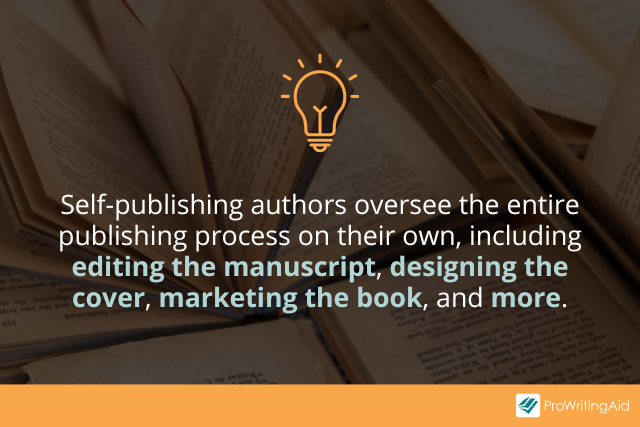
The alternative to this is traditional publishing, which involves getting a book deal with a traditional publishing house.
For a long time, traditional publishing was the only option for most writers who wanted to share their work with readers.
But it’s very hard to get a book traditionally published, because the process is incredibly selective. As a result, when traditional publishing was the only route, many writers weren’t able to publish their work at all.
With the advent of the digital age, it became much easier to skip the gatekeepers. In the 1990s, it became possible for authors to release eBooks online without going through a traditional publishing company.
These days, many authors choose to use a self-publishing platform, such as Amazon’s KDP or IngramSpark.
These platforms make it easy for the author to produce and ship both eBooks and physical books. According to Statista, about 1.7 million books are self-published each year.
Self-Published Authors and Books
There’s a common misconception that self-publishing can never lead to commercial success, but many authors have proven this misconception wrong.
Here are five stories of self-published authors who have achieved commercial success and even become household names.
1. Christopher Paolini
Christopher Paolini started writing the YA epic fantasy novel Eragon when he was only 15. At age 19, he self-published the book with the help of his parents’ small publishing company, Paolini International.
He promoted it heavily by touring the US and giving talks at schools, libraries, bookstores, and more.
Eventually, the book became a huge hit. Paolini later got a publishing deal with Alfred A. Knopf, and the series has now sold over 35 million copies.
2. Andy Weir
Andy Weir self-published The Martian, his near-future sci-fi novel. He originally chose to release the book one chapter at a time on his website, after being turned down by literary agents when he tried to publish his previous work.
Fans loved the book so much that they convinced Weir to self-publish the book on Amazon Kindle. It sold so well that it was picked up by Crown in 2013, debuted as a New York Times bestseller, and got adapted into a major motion picture starring Matt Damon.
3. Hugh Howey
Hugh Howey self-published Wool, a post-apocalyptic sci-fi story, as a standalone short story through Amazon KDP in 2011.
He cited creative freedom as one of the main reasons he chose this publishing path. The story gained so much popularity that Howey wrote sequels and ended up signing a deal with Simon & Schuster.
4. Lisa Genova
Lisa Genova self-published Still Alice in 2007 after being rejected by literary agents. She marketed the book on her own, even selling physical copies from her car.
Later, she found an agent and got a publishing deal with Simon & Schuster. Her book was even turned into a movie starring Julianne Moore.
5. Rupi Kaur
Rupi Kaur became famous through the “Instagram poetry” movement. She self-published several poetry collections, including milk and honey, which scored millions of readers and became a runaway hit. It was later picked by Andrews McMeel Publishing.
Benefits of Self-Publishing Your Own Book
There are several notable benefits to self-publishing your work, as opposed to selling it to a traditional publisher.
Benefit 1: Retain Full Creative Control
When you choose a traditional publishing route, the publisher has a lot of creative control over the final product. They get to play a large role in deciding the developmental edits you make, how your book will be marketed, and even what the cover design will look like.
Many authors prefer to keep creative control over the book they’ve written. For these authors, self-publishing can be a great path, because they get to decide what their book looks like and how it gets put out into the world.
Benefit 2: Skip the Gatekeepers
The process of selling a book to a traditional publisher involves a lot of gatekeeping. If you aren’t sure what traditional editors and literary agents are looking for, it might be better to self-publish, which lets you skip the gatekeepers.
For example, if you’re writing a book on a very niche topic, the big publishing houses might not think it’s worth their while because the target audience isn’t large enough. By self-publishing, you can still make your book available to interested readers.
Similarly, many authors with non-traditional books that don’t fit the usual mold have found better success using a self-publishing service. That way, they don’t have to jump through the hoops of traditional publishing first.
Benefit 3: Earn Higher Royalties
When you go down the traditional publishing route, the agent and publisher will take a large cut of the profit your book makes.
By self-publishing, you get to keep all the profits for yourself, which can be a good return on investment if you make enough sales.
On the flip side, self-publishing authors don’t get an advance, which is a signing bonus received before the book is published, the way traditionally published authors do. So you may have to wait a while before you start turning a profit.
Benefit 4: Publish Faster
If you decide to traditionally publish your work, you will likely have to wait two or more years between the day you get your book deal and the day your book actually hits the shelves.
That’s because traditional publishing is a slow process. Your manuscript has to go through several steps at the publishing house, from contract negotiation to developmental editing to copyediting to marketing and so much more.
Also, publishing houses schedule their book releases for specific seasons, and they might slot you into the season that they feel suits your book best.
If you self-publish, on the other hand, the speed of your publication process is entirely under your control.
The only limiting factor is how fast you can get everything done. If your book can be ready to go a month from now, you can release it in a month.
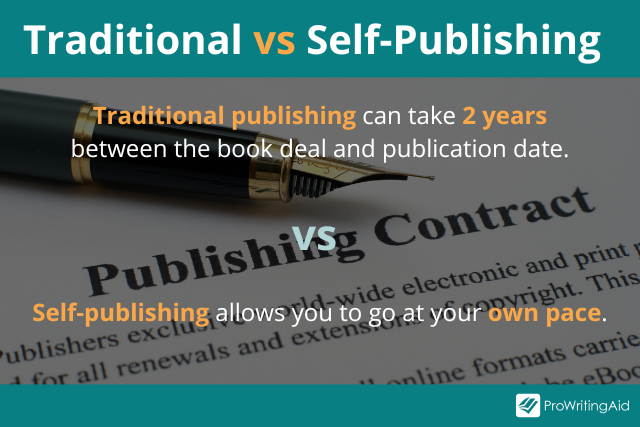
This is an especially important benefit for prolific writers, who might be able to churn out multiple books a year. Releasing those books quickly can help you earn revenue faster.
Benefit 5: Complete a Series
If you’re writing a long series, there’s no guarantee that a traditional publishing house will agree to publish the entire series.
Most likely, you’ll need to pitch your book as a “standalone with series potential,” and if the first book sells well enough, the publishing house will agree to publish more. Otherwise, you’ll never be able to release the entire series.
For authors of long series, it might be better to pursue self-publishing, so you can make sure the whole series gets completed.
What Do You Need to Self-Publish a Book?
Let’s look at the things you need in order to create a professionally published book on your own.
Requirement 1: Money
You need a budget you’re willing to invest in your book. When you go down a traditional publishing path, the publishing house pays for all upfront costs, such as hiring book editors, cover designers, and marketing professionals.
When you self-publish, you have to pay for all those costs on your own—and these investments have to happen long before your book can start making a profit.
Here’s a quick breakdown of some of the approximate costs you’ll need to consider:
- A self-publishing service costs $0–$100
- An International Standard Book Number (ISBN) costs $100–$300
- A professional cover design costs $100–$1,000
- A developmental editing service costs around $500–$1,000
- Marketing and promotion costs $0–$10,000
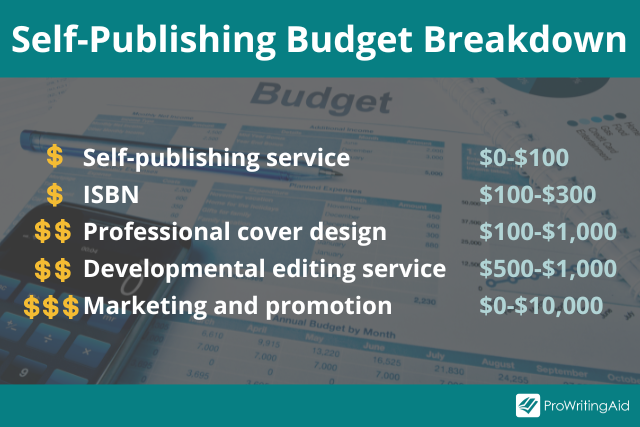
You should know how much money you’re willing to spend on each step. Will you pay for a professional developmental editor? Will you buy ads for your book? Will you pay for reviews? Start by creating a budget for yourself and take it from there.
Requirement 2: Time
If you go down the traditional publishing route, traditional publishers will pay experts to dedicate time to editing, marketing, and selling your book.
However, if you self-publish, you’ll need to do all those jobs on your own or cover the cost of hiring professionals.
Being a self-published author can feel like juggling three full-time jobs: writer, editor, and marketer. You have to be willing to make the time to wear all three of those hats.
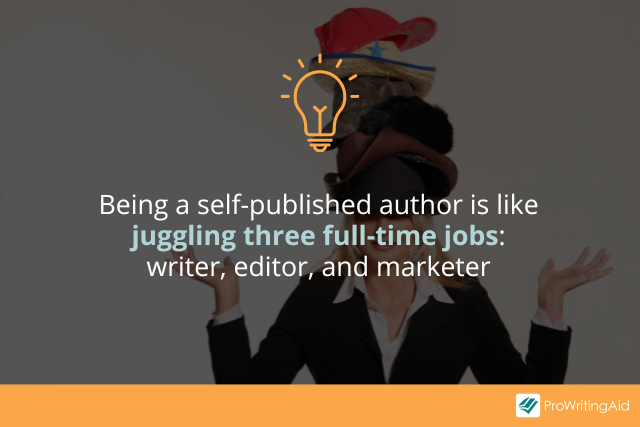
Block out time for yourself to focus on each of these jobs. Whether it’s waking up an hour early every morning, or dedicating your lunch break to the job, you may have to get creative to make sure you have enough time to make your book a success.
Requirement 2: Motivation
You also need a lot of initiative and a willingness to put in the work to make your book a success. There will be nobody holding your hand along the way—it’s all up to you. Keeping up the motivation to stay on track and set your own deadlines will be crucial.
The process doesn’t end when you hit “Publish.” You’ll still need to continuously market your book and help it find its audience. Many self-publishing books have died after their debut weeks because the author lost motivation to continue building sales.
Every writer has days when they doubt themselves or wonder if it’s worth it.
Try to find small ways to motivate yourself. Imagine a reader holding your book in their hands and falling in love with it. Or imagine yourself giving an author interview about the inspiration for your story. The key is to remember what you’re doing this for.
12 Steps for Self-Publishing a Book
Now that we’ve covered the major pros and cons of self-publishing, it’s time to get down to the nitty-gritty! What steps do you actually need to take to become a self-published author?
Here’s our step-by-step guide for how to self-publish a book:
- Step 1: Finish your manuscript
- Step 2: Complete developmental edits
- Step 3: Complete copyedits and proofreading
- Step 4: Choose a compelling title
- Step 5: Write a back cover blurb
- Step 6: Choose a self-publishing platform
- Step 7: Format your book
- Step 8: Design your cover
- Step 9: Find distribution channels
- Step 10: Create a marketing plan
- Step 11: Buy an ISBN
- Step 12: Hit publish!

Step 1: Finish Your Manuscript
The first step of self-publishing your book is the hardest step by far. In order to self-publish a book, you need to have a complete manuscript first, with a beginning, a middle, and an end.
For more tips on how to write a first draft, check out our article on how to write a book.
If you’ve already completed this step, congratulations—the hardest part is over! Now that you’ve written the words “The End,” it’s time to take the next step toward publication.
Step 2: Complete Developmental Edits
There are many stages of editing a book. Before you even think about looking for typos, you need to start by fixing the big-picture issues within your manuscript.
If you’re writing a novel, for example, you should consider the following questions:
- How’s the pacing?
- Are all the character arcs clear?
- Do all the subplots work together with the main plotline?
- Are the themes consistent?
If you’re writing a non-fiction book, you should ask yourself the following questions:
- Is your book organized correctly?
- Are there any topics that need more explanation?
Start by sharing your book with beta readers to ask for their feedback. One of the worst mistakes you can make as a self-published author is clicking “Publish” without letting anyone else see the manuscript first.
By the time it’s published, it will be too late to make changes—so make sure you get as much feedback as possible, early on in the process.
If you have room in your budget, hiring a professional developmental editor can help you catch any issues that need to be fixed early on.
Step 3: Complete Copyedits and Proofreading
Copyediting is a different part of the process from developmental editing.
At this stage, you’ll be looking for line-level issues in the manuscript. Are there any typos you need to fix? Any grammatical errors? Any snippets of dialogue that don’t flow as well as they should?
Changing the format of your manuscript, by printing it out or converting it into a PDF for example, can be a great way to spot errors that you’d otherwise skip over.
Another useful tip is to try reading your work out loud—your ears can catch awkward sentences and bad grammar better than your eyes can.
ProWritingAid can help you make sure your writing is clear and error-free.
Our free grammar checker can catch any mistakes in your manuscript and make suggestions to resolve them. You can also consider hiring a professional copyeditor or proofreader to make sure your manuscript is as polished as possible.
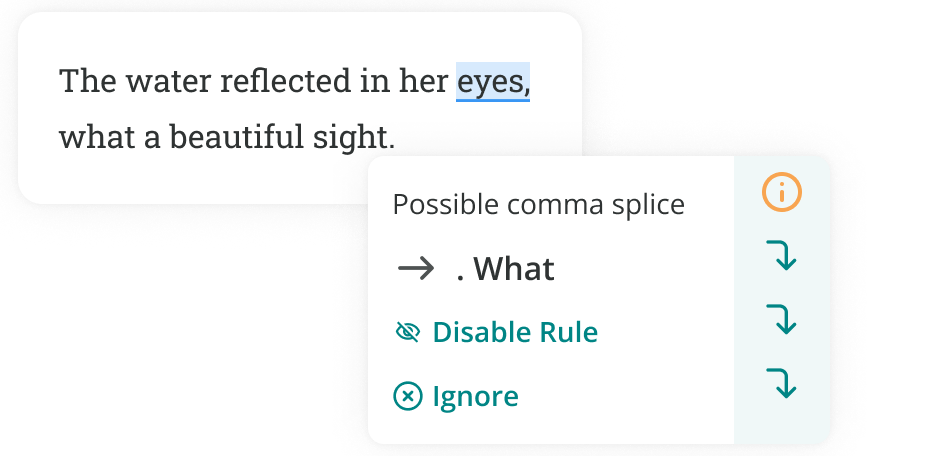
Step 4: Choose a Compelling Title
Your book title is your biggest marketing tool, and you should choose it carefully. Make sure it’s a title that will hook readers in and convince them to read the back cover blurb.
Start by thinking about your favorite book titles within the genre you’re writing in. What draws you in? Is there anything all your favorite titles have in common?
If you’re writing fiction, consider the following questions:
- Are there any characters with interesting names? (e.g. Coraline, A Man Called Ove)
- Is there a key element in the plot or premise that might draw readers in? (e.g. The Hunger Games, The War of the Worlds)
- Is there an interesting setting? (e.g. The House on Mango Street, The Starless Sea)
- Is there an intriguing phrase that describes your book well? (e.g. If I Stay, I Am the Messenger)
If you’re writing non-fiction, try these questions:
- Is there a key question your book answers? (e.g. Why Won’t You Apologize?)
- Does your book solve a specific problem? (e.g. How to Win Friends and Influence People)
- Are there any surprising contradictions that might intrigue people? (e.g. Why Fish Don’t Exist)
If you come up with multiple title options, you can ask your friends and beta readers which title they like best.
Step 5: Write a Back Cover Blurb
The back cover will give readers a high-level overview of what to expect when they buy your book. It should be 100–200 words, either all in the same paragraph or broken into different paragraphs.
You need to hook readers in. Tell them what your book can promise them and what makes your book unique.
If you’re writing non-fiction, make sure to explain the key questions that your book answers and why you have the credentials to answer those questions.
If you’re writing fiction, explain the goals the main characters are trying to pursue, the core conflict in their way, and what they’ll lose if they don’t succeed.
If you’re not sure how to write a back cover blurb, a great way to start is by going to your local bookstore and finding the shelf where your book would fit after publication.
Then, pick up the books on that shelf and read their back covers. Take note of which blurbs draw you in and why, and then try to emulate those elements on your own.
Step 6: Choose a Self-Publishing Platform
There are many popular self-publishing platforms with proven success stories. Some of the most widely used self-publishing companies include Amazon KDP, IngramSpark, Barnes & Noble Press, and Lulu.
Amazon KDP (Kindle Direct Publishing) is the most popular self-publishing platform by far, making up 40% of self-published digital books in the US. That’s because Amazon has a huge reach, including the Kindle Unlimited and KDP Select programs.
However, there are other benefits to going with a different platform, such as the ability to use more global distribution channels.
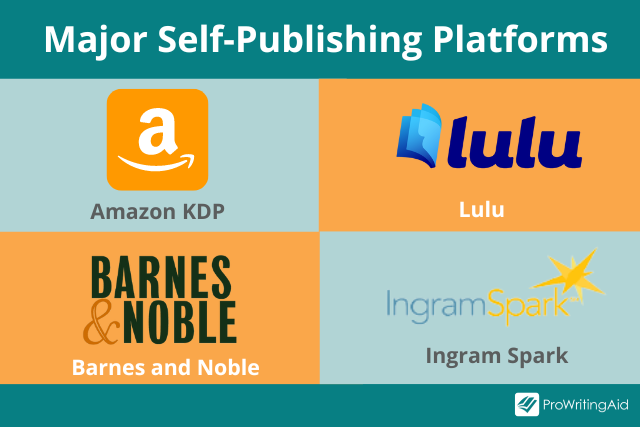
Here are some questions to consider when choosing a platform:
- How much do royalty rates matter to you?
- How much money are you willing to spend on this step of the process?
- Which distribution channels (e.g. physical bookstores, Amazon, libraries) are important to you?
- Do you want a platform with international reach?
- Do you need a platform that can give you resources and hold your hand throughout the self-publishing process, or are you okay with doing it all yourself?
You should consider the pros and cons of each platform and decide which one best suits your needs.
Step 7: Format Your Book
If you want a final product that looks professional and readable, you’ll need to format your book correctly.
Consider indentation, widows, orphans, hyphens, and other formatting elements. Keep in mind that you may need different formatting for print and eBook versions of your book, if you plan on releasing both formats.
Using formatting software can help streamline this process. Software like Scrivener and Drabble, for example, will let you export your book in a specific format. You can also hire a professional to help you format your book.
Step 8: Design Your Cover
The common adage “Don’t judge a book by its cover” is rarely followed by readers. They’ll definitely be judging your book by its cover.
Start by studying recent books in your genre to see what covers are drawing readers in. Are readers gravitating toward illustrated covers, covers with realistic photography, covers with fancy lettering, or something else entirely?
Unless you have experience designing cover art, you should hire a professional book cover designer. Even if the manuscript is incredible, readers will be less inclined to buy it if the cover looks amateurish.
Even if you hire a cover designer, you should also do some research on your own to see what types of covers suit your genre. You can even describe your vision to the cover designer, or sketch them a mockup of what you’re looking for.
Above all else, make sure the title and author name are clearly readable, and that your final cover design is simple enough to be recognizable in a thumbnail. It will be more useful as a marketing tool that way.
Step 9: Find Distribution Channels
Publishing houses have contacts with major distribution channels, such as Barnes & Noble. If you want to get your book into major bookstores, you’ll need to create a distribution plan on your own.
Some self-publishing platforms have specific distribution channels, such as Amazon, Apple Books, Barnes & Noble, and Google Play Books. If you’re using one of these platforms, you’ll already be well on your way.
Otherwise, you should make a list of bookstores, book fairs, online retailers, and libraries that can distribute your book to readers, and figure out how to get your book onto their shelves.
Step 10: Create a Marketing Plan
If you want your book to reach a large audience, you’ll need to create a clear marketing plan. It’s not enough to simply put your book on a platform like Amazon and hope that readers will find it on their own.
You should reach out to book reviewers. Many reputable book sites, such as Kirkus, offer reviews to self-published authors for a fee. There are also plenty of book bloggers and influencers who specialize in reviewing indie and self-published books.
If you don’t have a budget to pay for reviews, you can ask your fellow authors to review your book, and offer to review theirs in exchange.
You can also set your prices to match your marketing strategy. For example, some authors price their books at $0.99 during their launch period to encourage book sales, and then raise the price as sales increase.
Step 11: Buy an ISBN
An International Standard Book Number or ISBN is a thirteen-digit universal ID for your book, which you’ll often see at the top of a barcode.
You’ll need to buy an ISBN if you want to sell your book in bookstores, libraries, and most other retailers—they usually won’t sell your book without one.
Depending on the self-publishing platform you’re using, you might be able to buy your own ISBN through the platform itself. Otherwise, you can buy one directly from Bowkers.
A single ISBN costs about $125. Don’t forget that you need a separate ISBN for each version of your book, so if you want to publish in both paperback, audiobook, and eBook, you’ll need three separate ISBNs.
Step 12: Hit Publish!
You can plan a launch event, such as a book signing at your local bookstore or a party in your neighborhood, to celebrate the launch of your book.
The journey doesn’t end here, of course. Your marketing plan, and your engagement with your fans and readers, will continue long after the book is published. But once you’ve reached this step, congratulations—you’re officially a published author!
Bonus Tips for Self-Publishing Your Book
Tip 1: Join the Writing and Reading Community
Self-publishing can sound like a solitary journey—after all, it even has “self” in the name. But don’t underestimate the power of community!
There are many experienced authors who are happy to help newer authors break into the field, as well as debut authors who are on the same step of the journey and are excited to grow together.
In addition to swapping tips about how to thrive in the industry, you can also help boost each other’s work. You can trade blurbs, posts on social media, and more.
Finally, booksellers and librarians in your city might be happy to help you promote your book. There’s no shame in walking into your local bookstore to introduce yourself and say hello.
Tip 2: Utilize Social Media
Social media is a great way to find your fellow authors and readers.
It’s important to choose social media platforms that suit you, rather than stretching yourself too thin by trying to be on all of them at once.
If you like taking photos, try Instagram. If you prefer writing short posts, opt for Twitter. You can make long-form videos on YouTube, or short-form videos on TikTok. There are writing communities everywhere.
Remember that social media isn’t just a sales tool, it’s also a community-building tool. Don’t limit yourself to posting reminders to buy your book—these posts feel like spam and can annoy readers.
Instead, try to genuinely engage with others who love the same things you do. Talk about your favorite characters, your writing process, your goals and fears. You might be surprised by how many people can relate to your experiences.
Tip 3: Know Your Elevator Pitch
Many authors dread the question, “So, what’s your book about?”
Pitching your book is a necessary step for many traditionally published authors. But you should know how to do this even if you’re self-published.
You should prepare an answer to this question that’s short, memorable, and enthusiastic. Being able to talk to people about your book will be crucial for generating interest, and it will also keep you from freezing up when you’re talking about your book at dinner parties.
Conclusion on How to Self-Publish a Book
Self-publishing isn’t an easy road, but it’s a great option for many authors who want to get their work out into the world. We hope this article gave you some useful tips for how to publish your own book.
Let us know in the comments if you have a self-published book you want to share. Good luck, and happy writing!


